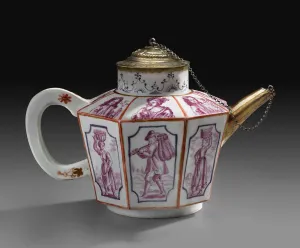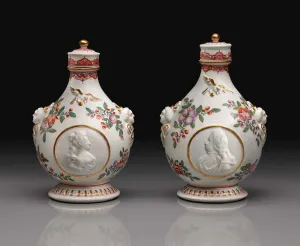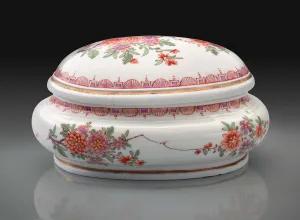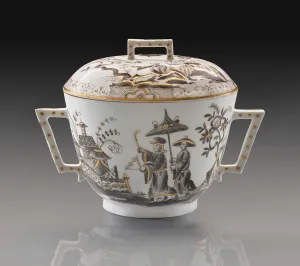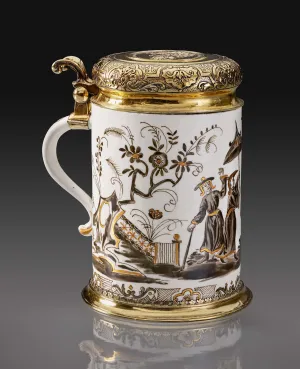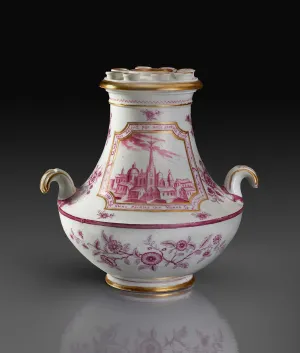The Early Years 1720–25
When the Du Paquier manufactory began production, about 1719, the Royal Porcelain Manufactory in Meissen, which had been in operation for almost a decade, exerted a strong influence. The flasks on display in the exhibition were derived from a model created at Meissen in 1711. The Viennese versions — decorated with profile portraits of the imperial couple, Emperor Charles VI and his wife Elisabeth Christine — became the most common flasks made by Du Paquier and were a popular diplomatic gift. The oval sugar box also corresponds to a standard Meissen model. Likewise, the small covered cup — the first object acquired by Melinda and Paul Sullivan — is identical to one regularly produced at Meissen. The cup, which could have been made in either factory, was decorated in Vienna by an unknown artist who specialized in the black monochrome decoration known as Schwarzlot.
About 1725, the manufactory produced a five-piece garniture of tulip vases (only four have survived, two of which are in this exhibition, view here and here) with inscriptions that proclaimed the manufactory’s achievements. Although the forms of the vases are inspired by Delftware — a typically blue-and-white pottery made in the Netherlands and adapted from Chinese porcelain — the bold messages declare the superiority of Viennese porcelain over Chinese porcelain.
During these early years, the Du Paquier manufactory focused not on the creation of new shapes but rather on developing a rich palette of colors, first perfecting underglaze blue, then monochrome decoration in purple, iron-red, and black, and finally adding brown, yellow, blue, and several shades of green. The experimentation of these early years and the influence of non-Viennese and itinerant porcelain artists resulted in a great variety of painted decoration.
Du Paquier Manufactory
Teapot, ca. 1720–25
Hard-paste porcelain and gilt metal mounts
H. 5 1/8 in. (13 cm)
The Frick Collection; Gift from the Melinda and Paul Sullivan Collection, 2016
Du Paquier Manufactory
Olio Pot (missing its cover), 1720–25
Hard-paste porcelain
4 1/2 × 6 5/8 in. (11.5 × 16.8 cm); diam. 6 1/2 in. (16.5 cm)
Melinda and Paul Sullivan Collection
Du Paquier Manufactory
Pair of Flasks with Relief Portraits of Emperor Charles VI and Empress Elisabeth Christine, ca. 1725–30
Hard-paste porcelain
One flask: 7 7/8 × 5 in. (20 × 12.7 cm); diam. 4 1/2 in. (11.4 cm)
The other: 8 1/8 × 5 1/4 in. (20.6 x 13.3 cm); diam. 4 1/2 in. (11.4 cm)
The Frick Collection; Gift from the Melinda and Paul Sullivan Collection, 2016
Du Paquier Manufactory
Sugar Box, ca. 1725
Hard-paste porcelain
Box (uncovered): 1 9/16 × 4 13/16 × 3 13/16 in. (3.9 × 12.2 × 9.7 cm)
Cover: 1 3/16 × 4 3/16 × 3 1/4 in. (3 × 10.6 × 8.3 cm)
H. (with cover): 2 3/8 in. (6 cm)
Melinda and Paul Sullivan Collection
Du Paquier Manufactory
Tankard, ca. 1725
Hard-paste porcelain
4 × 4 1/2 in. (10.2 × 11.5 cm); diam. 2 7/8 in. (7.3 cm)
Melinda and Paul Sullivan Collection
Du Paquier Manufactory
Covered Cup, 1725–30
Hard-paste porcelain
4 × 5 3/8 in. (10.2 × 13.6 cm); diam. 4 in. (10.2 cm)
Melinda and Paul Sullivan Collection
Du Paquier Manufactory
Tankard, ca. 1725
Hard-paste porcelain and silver-gilt mounts
H. (without lid) 4 3/4 in. (12 cm); diam. 2 3/4 in. (7 cm)
Melinda and Paul Sullivan Collection
Du Paquier Manufactory
Tulip Vase, ca. 1725
Hard-paste porcelain
8 3/8 × 8 1/2 in. (21.3 × 21.6 cm)
The Frick Collection; Gift from the Melinda and Paul Sullivan Collection, 2016
Du Paquier Manufactory
Tulip Vase, ca. 1725
Hard-paste porcelain
6 1/2 x 8 3/8 in. (16.5 x 21.3 cm)
Lent by The Metropolitan Museum of Art, Gift of R. Thornton Wilson, in memory of Florence Ellsworth Wilson, 1954 (54.147.94)

